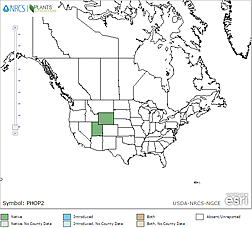Plant of the Week
 Range map of Phlox opalensis. USDA PLANTS Database.
Range map of Phlox opalensis. USDA PLANTS Database.
 Opal Phlox (Phlox opalensis) flower. Photo courtesy of Charmaine Delmatier.
Opal Phlox (Phlox opalensis) flower. Photo courtesy of Charmaine Delmatier.
 Opal Phlox (Phlox opalensis) flower. Photo courtesy of Charmaine Delmatier.
Opal Phlox (Phlox opalensis) flower. Photo courtesy of Charmaine Delmatier.
 Opal Phlox (Phlox opalensis) flower, white variation. Photo courtesy of Charmaine Delmatier.
Opal Phlox (Phlox opalensis) flower, white variation. Photo courtesy of Charmaine Delmatier.
 Opal phlox (Phlox opalensis) habitat. Photo courtesy of Charmaine Delmatier.
Opal phlox (Phlox opalensis) habitat. Photo courtesy of Charmaine Delmatier.
Opal Phlox (Phlox opalensis)
By Charmaine Delmatier, 2016
Unlike what some might think, not all plant species have been identified in the United States, or elsewhere in the world. According to R. Hartman and E. Nelson at the University of Wyoming, approximately 60 new plant species are described each year in North America.
Recently, in 1990, Opal phlox (Phlox opalensis), a showy phlox, was discovered by Robert Dorn near the small town of Opal, Wyoming. First considered a rare plant because of its new nature, with more surveys it became apparent it is more widespread than we once thought. However, even though more populations were located, it is still restricted to a small geographic area in the United States, specifically southwestern Wyoming.
Opal phlox is a member of the Polemoniaceae family. There are close to 25 genera and 400 species worldwide, both annuals and perennials, including herbs, shrubs, small trees, and vines. It is interesting that much of the diversity occurs in California. Some of the key family identifying features includes five sepals, five fused petals that often form a tube (corolla), and five stamens alternating between the corolla lobes. In most species, the stamens are also fused into the corolla tube symmetrically placed between each petal lobe. Another distinguishing family feature is that the ovary’s three carpels are usually fused while retaining three individual chambers.
Phlox is predominantly a North American genus; with approximately 65 species, and of those, twelve occur in Wyoming. “Phlox" is Greek for "flame." Opal phlox is a solid taxon and has no synonyms. The flowering petals (corolla) range from white to hot pink to dark fuchsia. It is a perennial herb forming loose mats with nearly erect stems. The total height of each plant barely reaches three inches. Different from the more common Hood’s phlox, its stem internodes are more elongate, whitish-transparent (hyaline), and have long, crinkly, spreading hairs. The leaves are 2 to 10 millimeters long, less than 1 millimeter wide, taper abruptly to a sharp tip, and have crinkly-pubescent (but not glandular) hairs at the base. Flowers are often strongly aromatic. The corolla is 12 to 15 millimeters wide and has 5 (rarely 6) wedge-shaped lobes. The shorter sharp-tipped calyx lobes are 6 to 8 millimeters long, and are also crinkly-pubescent.
For centuries, and thousands of years in some parts of the world, cultures have been utilizing several members of Polemoniaceae. The sweet-smelling long-leaved phlox was utilized by several North American nations including the Havasupai from Arizona; the Okanagan from British Columbia and Washington; the Paiute from California, Idaho, Nevada, Oregon, and Utah; the Shoshone from Idaho, Montana, Utah, and Wyoming; and the Washoe from Nevada and California. Internally, an infusion of the entire plant was given to anemic children and to babies with stomachaches. Externally, powdered roots can be rubbed over the body for colds and aches and leaves can be applied on boils and scorpion stings. Modern herbal remedies are becoming more popular with their medicinal properties being accepted readily. For example, Espinolla (Loeselia coccinea), a native herb in Mexico, is used as remedy for respiratory disease, stomach inflammation, and post-childbirth fever.
The radiant beauty of many members of the Polemoniaceae have been and are being recognized as important ornamentals; and in Bolivia and Peru, it has become a national treasure. Kantuta (Cantua buxiolia) is the national flower of Bolivia and Peru and revered as a ‘magic flower’ and the ‘sacred flower of the Incas’. The stripes on the Bolivian flag represent red, yellow, and green hues from the Kantuta flower.

